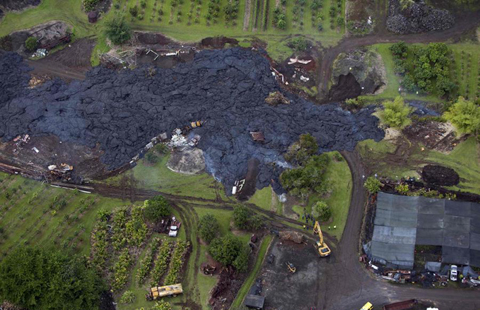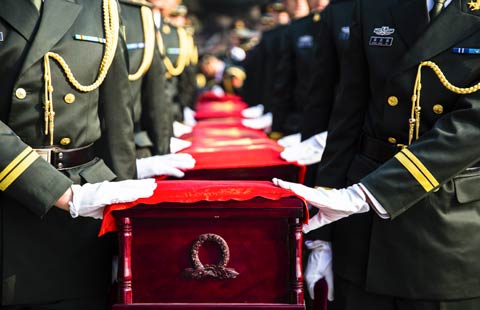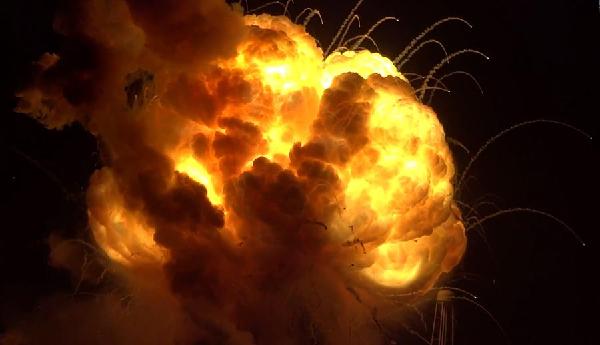Probe started over US rocket explosion
Updated: 2014-10-30 07:06
(Agencies)
|
||||||||
WALLOPS, Va./CAPE CANAVERAL, Fla. - Authorities on Wednesday started investigating what caused an unmanned US supply rocket to explode in a fireball moments after liftoff from a Virginia launch pad, destroying supplies and equipment bound for the International Space Station.
The 14-story Antares rocket, built and launched by Orbital Sciences Corp, blasted off from the NASA Wallops Flight Facility on Wallops Island at 6:22 pm (2222 GMT) on Tuesday but burst into flames moments later. It was the first disaster since the National Aeronautics and Space Administration turned to private operators to run cargo to the space station.
While no one was hurt, witnesses said the explosion looked like a "ball of fire" and shook buildings for miles.
"The explosion was a big boom - we could also feel it here, just the ground shaking," said Shirley Lapole, assistant education coordinator at the NASA Visitors Center, who was watching the launch from about seven miles away.
The rocket carried a Cygnus cargo ship with more than 5,000 pounds (2,273 kg) of equipment and supplies for the station, a $100 billion research laboratory owned and operated by 15 nations that orbits about 260 miles (418 km) above Earth.
The area around the launch facility was cordoned off on Wednesday and a helicopter circled overhead. The Cygnus mission was non-military but the craft included classified cryptographic equipment, said Mike Pinkston, Orbital's Antares program manager, requiring heightened security.
Pieces of cloth-like debris were found scattered across Chincoteague Island, just northeast of Wallops Island and about 100 miles north of Norfolk on Virginia's Eastern Shore.
"GREAT LOSS"
Investigators will need days to determine where the failure began, said Frank Culbertson, an Orbital executive vice president and mission director, who placed the value of the rocket and cargo ship at $200 million. The exact cause may take longer to ascertain and correcting the problem could take months, he said. Meanwhile, Orbital has grounded the Antares, which previously made four flights, all successful.
Still, the loss of the supply vessel posed no immediate problem for the orbiting station's six-member crew: two from NASA, one from the European Space Agency and three Russians, officials said.
"It's a great loss when you lose a vehicle like that ... but we press on," NASA space station flight engineer Barry Wilmore said during an in-flight interview on Wednesday. "We've got supplies to last us four to six months."
The Antares rocket launched Tuesday included an enhanced second-stage engine, which allowed an additional 800 pounds of cargo to be loaded aboard Cygnus. It is not known if the rocket's extra weight and length were factors in the accident.
- Xinjiang publishes anti-terror brochures
- Security pact sealed with Afghanistan
- President Xi encourages international cultural exchanges
- Premier Li: China willing to help Afghan infrastructure
- Chinese FM: China, Asia-Pacific become community of shared destiny
- Foreign minister remarks on possibility of China-Japan summit

 Jack Ma: sports fan or the next mogul?
Jack Ma: sports fan or the next mogul?
 Hawaii lava crosses residential property
Hawaii lava crosses residential property
 Obama praises health workers fighting Ebola as 'heroes'
Obama praises health workers fighting Ebola as 'heroes'
 Chinese community still angry after double-murder conviction
Chinese community still angry after double-murder conviction
 Chinese tourists to US to reach 20m in 2020
Chinese tourists to US to reach 20m in 2020
 SOHO endows $10m to Yale
SOHO endows $10m to Yale
 Remains of Chinese volunteer force buried in Shenyang
Remains of Chinese volunteer force buried in Shenyang
 Former premier makes Hurun philanthropists list
Former premier makes Hurun philanthropists list
Most Viewed
Editor's Picks

|

|

|

|

|

|
Today's Top News
Probe started over US rocket explosion
Hagel: China, US should get relationship right
Cheating probe delays SAT scores
Chinese tourists to US to reach 20m
Tycoons' gift to Yale stirs debate
VW defends safety of recalled New Sagitar
Former premier makes Hurun philanthropists list
Xinjiang publishes anti-terror brochures
US Weekly

|

|








